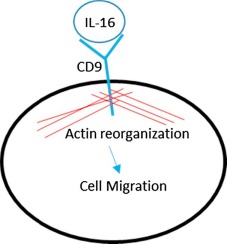Our official English website, www.x-mol.net, welcomes your
feedback! (Note: you will need to create a separate account there.)
Ablation of the CD9 receptor in human lung cancer cells using CRISPR/Cas alters migration to chemoattractants including IL-16
Cytokine ( IF 3.7 ) Pub Date : 2018-11-01 , DOI: 10.1016/j.cyto.2018.05.038
David J Blake 1 , Jonathon D Martiszus 1 , Tia H Lone 1 , Steven D Fenster 1
Cytokine ( IF 3.7 ) Pub Date : 2018-11-01 , DOI: 10.1016/j.cyto.2018.05.038
David J Blake 1 , Jonathon D Martiszus 1 , Tia H Lone 1 , Steven D Fenster 1
Affiliation

|
Graphical abstract Figure. No caption available. HighlightsCD9 expression was ablated in A549 cells using CRISPR/Cas technology.Wild‐type A549 cells migrated towards chemoattractants, however, CD9 expression was required in this process.CD9 knockdown cells had a significantly reduced migration towards growth serum and IL‐16.IL‐16 stimulation does not lead to the activation of a stress response in A549 cells. Abstract CD9, a member of the tetraspanin superfamily, has been implicated in regulating various physiological processes, including cell motility, adhesion, apoptosis and metastasis. Recently, interleukin‐16 (IL‐16), a pro‐inflammatory cytokine released by normal airway and alveolar epithelial cells, has been implicated as a possible ligand for CD9 as an alternative receptor. In this study, using A549 cells as a model of human alveolar epithelium, CD9 expression was ablated using CRISPR/Cas technology. Decreased expression of CD9 mRNA and protein levels was confirmed through RT‐qPCR and flow cytometry, respectively. Individual clones were generated that expressed high levels of CD9 (wild‐type, WT) or significantly less CD9 (knockdown, KD). Both wild‐type and knockdown A549 cell migration was quantified using a FluoroBloc transwell chemotaxis assay. Our results indicate that wild‐type A549 cells migrated towards chemoattractants. Moreover, CD9 expression was required in this process since the CD9 knockdown cells had a significantly reduced migration towards growth serum and IL‐16. These results support the migratory properties for CD9 in human lung cells and support the hypothesis that CD9 serves as an alternative receptor for IL‐16.
中文翻译:

使用 CRISPR/Cas 消除人肺癌细胞中的 CD9 受体会改变向包括 IL-16 在内的化学引诱物的迁移
图形抽象图。没有可用的字幕。亮点使用 CRISPR/Cas 技术在 A549 细胞中消融 CD9 表达。野生型 A549 细胞向化学引诱物迁移,但是在此过程中需要 CD9 表达。CD9 敲低细胞向生长血清和 IL-16.IL-的迁移显着减少16 刺激不会导致 A549 细胞中应激反应的激活。摘要 CD9 是四跨膜蛋白超家族的成员,参与调节各种生理过程,包括细胞运动、粘附、凋亡和转移。最近,白细胞介素 16 (IL-16) 是一种由正常气道和肺泡上皮细胞释放的促炎细胞因子,被认为是 CD9 作为替代受体的可能配体。在这项研究中,使用 A549 细胞作为人类肺泡上皮模型,使用 CRISPR/Cas 技术消融 CD9 表达。分别通过 RT-qPCR 和流式细胞术证实 CD9 mRNA 和蛋白质水平的表达降低。产生的单个克隆表达高水平的 CD9(野生型,WT)或显着较少的 CD9(击倒,KD)。使用 FluoroBloc transwell 趋化性测定对野生型和敲低 A549 细胞迁移进行量化。我们的结果表明野生型 A549 细胞向化学引诱物迁移。此外,该过程需要 CD9 表达,因为 CD9 敲低细胞向生长血清和 IL-16 的迁移显着减少。这些结果支持 CD9 在人肺细胞中的迁移特性,并支持 CD9 作为 IL-16 的替代受体的假设。
更新日期:2018-11-01
中文翻译:

使用 CRISPR/Cas 消除人肺癌细胞中的 CD9 受体会改变向包括 IL-16 在内的化学引诱物的迁移
图形抽象图。没有可用的字幕。亮点使用 CRISPR/Cas 技术在 A549 细胞中消融 CD9 表达。野生型 A549 细胞向化学引诱物迁移,但是在此过程中需要 CD9 表达。CD9 敲低细胞向生长血清和 IL-16.IL-的迁移显着减少16 刺激不会导致 A549 细胞中应激反应的激活。摘要 CD9 是四跨膜蛋白超家族的成员,参与调节各种生理过程,包括细胞运动、粘附、凋亡和转移。最近,白细胞介素 16 (IL-16) 是一种由正常气道和肺泡上皮细胞释放的促炎细胞因子,被认为是 CD9 作为替代受体的可能配体。在这项研究中,使用 A549 细胞作为人类肺泡上皮模型,使用 CRISPR/Cas 技术消融 CD9 表达。分别通过 RT-qPCR 和流式细胞术证实 CD9 mRNA 和蛋白质水平的表达降低。产生的单个克隆表达高水平的 CD9(野生型,WT)或显着较少的 CD9(击倒,KD)。使用 FluoroBloc transwell 趋化性测定对野生型和敲低 A549 细胞迁移进行量化。我们的结果表明野生型 A549 细胞向化学引诱物迁移。此外,该过程需要 CD9 表达,因为 CD9 敲低细胞向生长血清和 IL-16 的迁移显着减少。这些结果支持 CD9 在人肺细胞中的迁移特性,并支持 CD9 作为 IL-16 的替代受体的假设。































 京公网安备 11010802027423号
京公网安备 11010802027423号